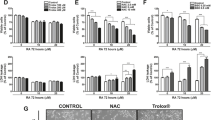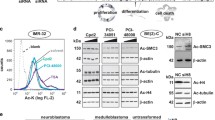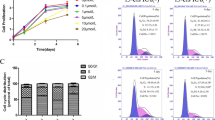Abstract
We hypothesized that induction of differentiation with retinoid could increase sensitivity to microtubule-binding drug taxol (TXL) for apoptosis in human glioblastoma T98G and U87MG cells. Treatment of cells with 1 μM all-trans retinoic acid (ATRA) or 1 μM 13-cis retinoic acid (13-CRA) for 7 days induced astrocytic differentiation, overexpression of glial fibrillary acidic protein (GFAP), and also down regulated telomerase expression and activity, thereby increased sensitivity to TXL for apoptosis. Treatment of glioblastoma cells with TXL triggered production of reactive oxygen species (ROS), induced phosphorylation of p38 mitogen-activated protein kinase (MAPK), and activated the redox-sensitive c-Jun NH2-terminal kinase 1 (JNK1) pathway. Moreover, TXL activated Raf-1 kinase for phosphorylation and inactivaion of anti-apoptotic Bcl-2 protein. The events of apoptosis included increase in expression of Bax, down regulation of Bcl-2 and baculoviral inhibitor-of-apoptosis protein (IAP) repeat containing (BIRC) proteins, mitochondrial release of cytochrome c and Smac into the cytosol, increase in intracellular free [Ca2+], and activation of calpain, caspase-9, and caspase-3. Increased activity of caspase-3 cleaved inhibitor of caspase-activated DNase (ICAD) to release and translocate CAD to the nucleus for DNA fragmentation. Involvement of stress signaling kinases and proteolytic activities of calpain and caspase-3 in apoptosis was confirmed by pretreating cells with specific inhibitors. Taken together, our results suggested that retinoid (ATRA or 13-CRA) induced astrocytic differentiation with down regulation of telomerase activity to increase sensitivity to TXL to enhance apoptosis in glioblastoma cells. Thus, combination of retinoid and TXL could be an effective therapeutic strategy for controlling the growth of glioblastoma.








Similar content being viewed by others
Abbreviations
- ANOVA:
-
Analysis of variance
- Asc:
-
Ascorbic acid
- ATRA:
-
All-trans retinoic acid
- BIRC:
-
Baculovirus IAP repeat containing
- CAD:
-
Caspase-3-activated DNase
- 13-CRA:
-
13-cis Retinoic acid
- DMSO:
-
Dimethyl sulfoxide
- HRP:
-
Horseradish peroxidase
- hTERT:
-
Human telomerase reverse transcriptase (hTERT)
- IAP:
-
Inhibitor-of-apoptosis protein
- ICAD:
-
Inhibitor of caspase-3-activated DNase
- Kd :
-
Dissociation constant
- MAPK:
-
Mitogen-activated protein kinase
- p-NA:
-
p-Nitroanilide
- OD:
-
Optical density
- ROS:
-
Reactive oxygen species
- RT-PCR:
-
Reverse transcription-polymerase chain reaction
- SBDP:
-
Spectrin breakdown product
- TXL:
-
Taxol
- SB203580:
-
4-(4-Fluorophenyl)-2-(4-methylsulfinyl phenyl)-5-(4-pyridyl)-1H-imidazole
References
Wang TH, Wang HS, Soong YK (2000) Paclitaxel-induced cell death: where the cell cycle and apoptosis come together. Cancer 88:2619–2628
Pendino F, Flexor M, Delhommeau F, Buet D, Lanotte M, Segal-Bendirdjian E (2001) Retinoids down regulate telomerase and telomere length in a pathway distinct from leukemia cell differentiation. Proc Natl Acad Sci USA 98:6662–6667
Dragnev KH, Rigas JR, Dmitrovsky E (2000) The retinoids and cancer prevention mechanisms. Oncologist 5:361–368
Thalasila A, Poplin E, Shih J, Dvorzhinski D, Capanna T, Doyle-Lindrud S, Beers S, Goodin S, Rubin E, DiPaola RS (2003) A phase I trial of weekly paclitaxel, 13-cis retinoic acid, and interferon-α in patients with prostate cancer and other advanced malignancies. Cancer Chemother Pharmacol 52:119–124
Vaishampayan U, Flaherty L, Du W, Hussain M (2001) Phase II evaluation of paclitaxel, α-interferon, and cis-retinoic acid in advanced renal cell carcinoma. Cancer 92:519–523
Yu C, Wang S, Dent P, Grant S (2001) Sequence-dependent potentiation of paclitaxel-mediated apoptosis in human leukemia cells by inhibitors of the mitogen-activated protein kinase kinase/mitogen-activated protein kinase pathway. Mol Pharmacol 60:143–154
Das A, Banik NL, Ray SK (2007) Garlic compounds generate reactive oxygen species leading to activation of stress kinases and cysteine proteases for apoptosis in human glioblastoma cells. Cancer 110:1083–1095
Das A, Sribnick EA, Wingrave JM, Wilford GG, Del Re AM, Woodward JJ, Appel SH, Banik NL, Ray SK (2005) Calpain activation in apoptosis of ventral spinal cord 4.1 (VSC4.1) motoneurons exposed to glutamate: Calpain inhibition provided functional neuroprotection. J Neurosci Res 81:551–562
Das A, Garner DP, Wilford GG, Del Re AM, Kumar DM, Woodward JJ, Banik NL, Agrawal N, Ray SK (2006) Calpeptin provides functional neuroprotection to rat retinal ganglion cells following Ca2+ influx. Brain Res 1084:146–157
Das A, Banik NL, Ray SK (2006) Mechanism of apoptosis with the involvement of proteolytic activities of calpain and caspases in human malignant neuroblastoma SH-SY5Y cells exposed to flavonoids. Int J Cancer 119:2575–2585
Kim NW, Piatyszek MA, Prowse KR, Harley CB, West MD, Ho PL, Coviello GM, Wright WE, Weinrich SL, Shay JW. (1994) Specific association of human telomerase activity with immortal cells and cancer. Science 66:2011–2015
Reid AB, Kurten RC, McCullough SS, Brock RW, Hinson JA (2005) Mechanisms of acetaminophen-induced hepatotoxicity: role of oxidative stress and mitochondrial permeability transition in freshly isolated mouse hepatocytes. J Pharmacol Exp Ther 312:509–516
Ray SK, Patel SJ, Welsh CT, Wilford GG, Hogan EL, Banik NL (2002) Molecular evidence of apoptotic death in malignant brain tumors including glioblastoma multiforme: upregulation of calpain and caspase-3. J Neurosci Res 69:197–206
Smiley ST, Reers M, Mottola-Hartshorn C, Lin M, Chen A, Smith TW, Steele GD Jr, Chen LB (1991) Intracellular heterogeneity in mitochondrial membrane potentials revealed by a J-aggregate-forming lipophilic cation JC-1. Proc Natl Acad Sci USA 88:3671–3675
Deissler H, Blass-Kampmann S, Bruyneel E, Mareel M, Rajewsky MF (1999) Neural cell surface differentiation antigen gp130 (RB13–6) induces fibroblasts and glioma cells to express astroglial proteins and invasive properties. FASEB J 13:657–666
Jakubowski W, Bartosz G (2000) 2,7-dichlorofluorescein oxidation and reactive oxygen species: what does it measure? Cell Biol Int 24:757–760
Aoshiba K, Yasui S, Nishimura K, Nagai A (1999) Thiol depletion induces apoptosis in cultured lung fibroblasts. Am J Respir Cell Mol Biol 21:54–64
Yamamoto K, Ichijo H, Korsmeyer SJ (1999) Bcl-2 is phosphorylated and inactivated by an ASK1/Jun N-terminal protein kinase pathway normally activated at G2/M. Mol Cell Biol 19:8469–8478
Fan M, Du L, Stone AA, Gilbert KM, Chambers TC (2000) Modulation of mitogen-activated protein kinases and phosphorylation of Bcl-2 by vinblastine represent persistent forms of normal fluctuations at G2/M1. Cancer Res 60:6403–6407
Silke J, Vaux DL (2001) Two kinds of BIR-containing protein - inhibitors of apoptosis, or required for mitosis. J Cell Sci 114:1821–1827
Wingrave JM, Sribnick EA, Wilford GG, Matzelle DD, Mou JA, Ray SK, Hogan EL, Banik NL (2004) Higher calpastatin levels correlate with resistance to calpain-mediated proteolysis and neuronal apoptosis in juvenile rats after spinal cord injury. J Neurotrauma 21:1240–1254
Yuan Q, Ray RM, Johnson LR (2000) Polyamine depletion prevents camptothecin-induced apoptosis by inhibiting the release of cytochrome c. Am J Physiol Cell Physiol 282:C1290–C1297
Blagosklonny MV, Giannakakou P, Deiry WS, Kingston DG, Higgs PI, Neckers L, Fojo T (1997) Raf-1/Bcl-2 phosphorylation: a step from microtubule damage to cell death. Cancer Res 57:130–135
Kumanishi T, Usui H, Ichikawa T, Nishiyama A, Katagiri T, Abe S, Yoshida Y, Washiyama K, Kuwano R, Sakimura K (1992) Human glial fibrillary acidic protein (GFAP): molecular cloning of the complete cDNA sequence and chromosomal localization (chromosome 17) of the GFAP gene. Acta Neuropathol 83:569–578
Feng J, Funk WD, Wang S-S, Weinrich SL, Avilion AA, Chiu CP, Adams RR, Chang E, Allsopp RC, Yu J. (1995) The RNA component of human telomerase. Science 269:1236–1241
Meyerson M, Counter CM, Eaton EN, Ellisen LW, Steiner P, Caddle SD, Ziaugra L, Beijersbergen RL, Davidoff MJ, Liu Q, Bacchetti S, Haber DA, Weinberg RA (1997) hEST2, the putative human telomerase catalytic subunit gene, is upregulated in tumor cells and during immortalization. Cell 90:785–795
Acknowledgments
This investigation was supported in part by the R01 grants (CA-91460 and NS-57811) from the National Institutes of Health (Bethesda, MD, USA).
Author information
Authors and Affiliations
Corresponding author
Rights and permissions
About this article
Cite this article
Das, A., Banik, N.L. & Ray, S.K. Retinoids induced astrocytic differentiation with down regulation of telomerase activity and enhanced sensitivity to taxol for apoptosis in human glioblastoma T98G and U87MG cells. J Neurooncol 87, 9–22 (2008). https://doi.org/10.1007/s11060-007-9485-1
Received:
Accepted:
Published:
Issue Date:
DOI: https://doi.org/10.1007/s11060-007-9485-1




